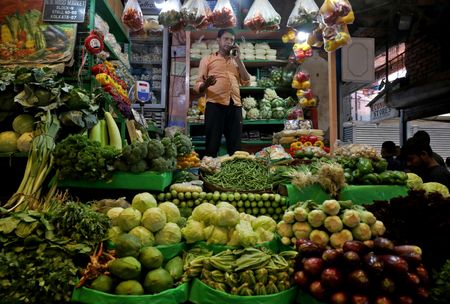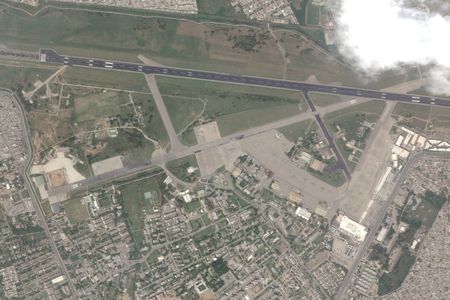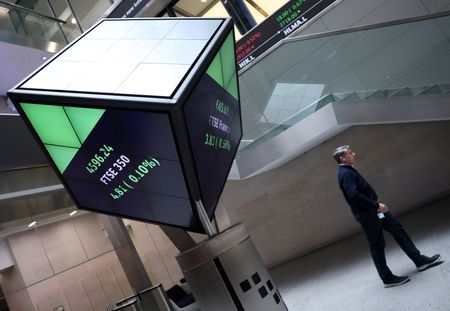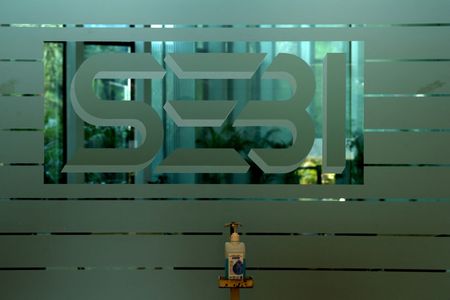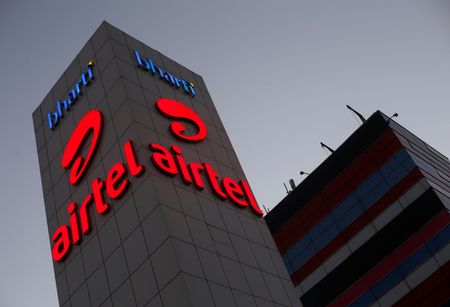(Reuters) – India’s retail inflation remained below the central bank’s 4% target for the third consecutive month as food prices rose at a slower pace, opening up room for more interest rate cuts to support growth in the world’s fifth-largest economy.
Annual retail inflation slowed to 3.16% in April from 3.34% in March, marking its lowest level since July 2019 and coming in below economists’ estimate of 3.27% in a Reuters poll.
Inflation in food prices – which accounts for nearly half of the consumption basket – slowed to 1.78% from 2.69% in March, its lowest since October 2021.
COMMENTARY:
SAKSHI GUPTA, PRINCIPAL ECONOMIST, HDFC BANK, GURUGRAM
“Inflation inched down to 3.16% in April on the back of a continuous broad-based drop in food prices, including of vegetables, cereals and pulses. The CPI print today sets the stage for another rate cut by the RBI (Reserve Bank of India) in its June meeting, of 25 basis points.”
“Looking ahead, inflation is expected to remain close to 3% over the coming two months. The expectation of an above-normal monsoon and low commodity prices bodes well for the inflation trajectory through the year. We expect inflation to average at 3.7% in fiscal 2026.”
RADHIKA RAO, SENIOR ECONOMIST, DBS BANK, SINGAPORE
“Along our expectations, April inflation remained below 4% for a third successive month, slowing from March’s 3.4% to 3.2% year on year.”
“Even as food perishables fell by a lesser extent than in March amidst a shift in weather conditions, the sequential momentum was better contained than last year. A pullback in global energy prices and a firmer currency kept imported pressures in check. We don’t expect any spillover risk to inflation from recent geopolitical developments.”
ADITI GUPTA, ECONOMIST, BANK OF BARODA, MUMBAI
“The outlook on food inflation remains positive, driven by an early onset of monsoon as well as robust rabi production. The benign global commodity price cycle suggests that core inflation should stabilise going ahead. With inflation under control, the RBI’s focus is expected to be on growth. We expect another 50 bps reduction in rates this year.”
GAURA SEN GUPTA, INDIA ECONOMIST, IDFC FIRST BANK, MUMBAI
“Inflation outlook remains positive, with expectation of an evenly distributed monsoon and subdued global commodity prices. Fiscal 2026 inflation is expected to average at 3.5% with downside risk.”
“Domestic factors alone provide space to ease policy rates by 75 bps in the remainder of FY26. Negative output gap and subdued commodity prices are expected to keep core inflation contained at 4.5% in FY26 vs 3.6% in FY25. High-frequency food prices indicate a continued decline in prices in May.”
“Next few inflation prints could be sub-3%.”
MADHAVANKUTTY G, ECONOMIST, CANARA BANK, BENGALURU
“The CPI print for April once again makes a strong case for another 25 bps cut in June. Rural inflation continues to trend down, which gives credence to the fact that rural demand has started showing green shoots.”
“Inflation in health, personal care and transport shows a rate higher than average, which gives credence to muted demand for these products. The FMCG financials also testify to this. Overall, we are heading towards a situation where CPI for FY26 could be well below RBI estimates of 4%.”
ADITI NAYAR, CHIEF ECONOMIST, ICRA, GURUGRAM
“The benign April 2025 headline inflation print, expectations of another sub-4% print in May 2025, the dip in crude oil prices in the recent weeks, and the IMD’s forecast of an above-normal monsoon in 2025 as well as an early onset will allow the (central bank) to continue to place a higher weight on growth vis-a-vis inflation, when it meets in June 2025.”
“A 25-bps rate cut appears forthcoming in the June 2025 policy, followed by easing of 25 bps each in the August and October 2025 policy reviews.”
“If the GDP growth print for the fourth quarter of fiscal 2025 does not report an acceleration from the 6.2% seen for the third quarter, the central bank may consider front-loading the rate easing, with a 50 bps cut in the upcoming review.”
(Reporting by Chris Thomas, Hritam Mukherjee and Kashish Tandon in Bengaluru, Siddhi Nayak in Mumbai; Compiled by Savio D’Souza)

